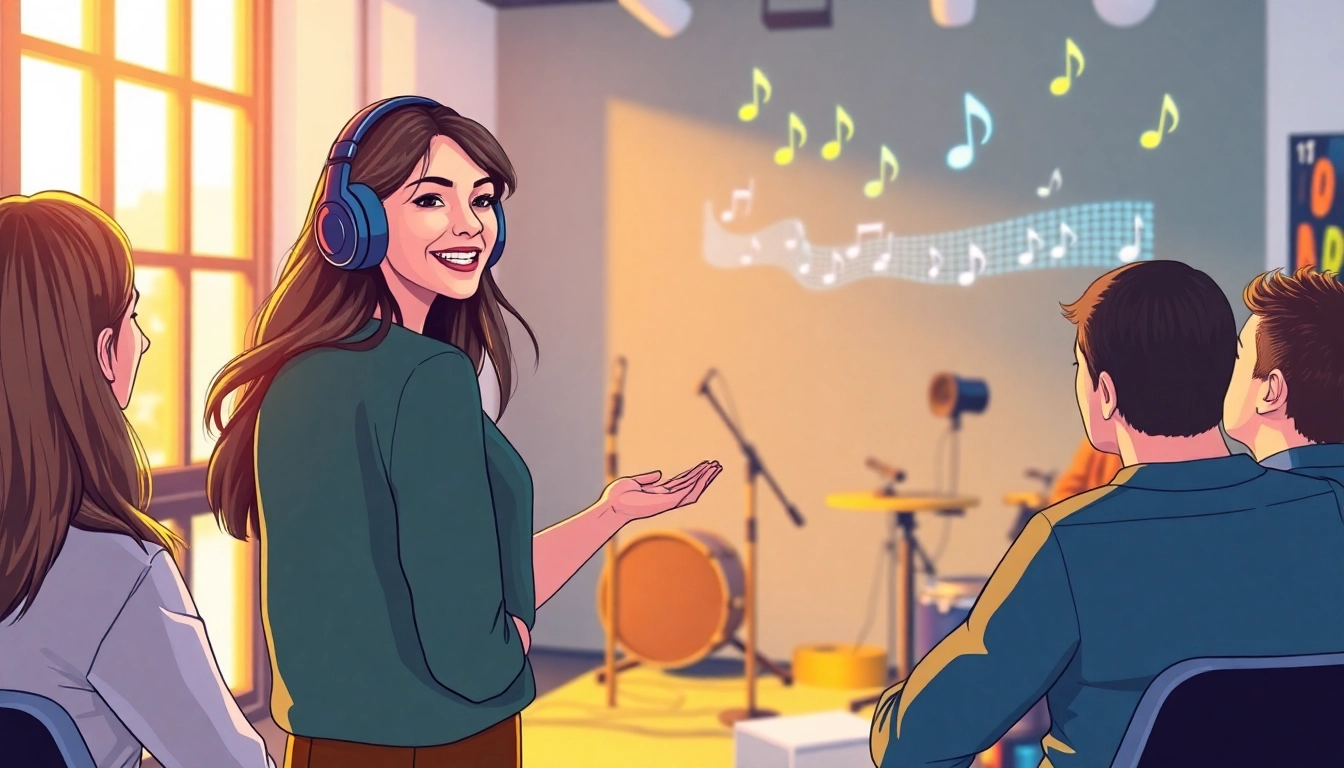Mastering Music Pitching: Essential Techniques for Achieving Playlist Success

Understanding Music Pitching
In an industry where talent alone doesn’t ensure success, understanding the nuances of music pitching is crucial for aspiring musicians, songwriters, and producers. Music pitching refers to the process of presenting a song or track to potential listeners, curators, or playlist managers to gain exposure, placements, and opportunities for broader reach. This article aims to demystify the music pitching landscape and provide actionable insights for artists looking to elevate their music careers.
What is Music Pitching?
At its core, music pitching involves sharing a specific piece of music with key stakeholders in the industry—playlists, radio stations, music blogs, influencers, and beyond. It is not merely about sending a song; it encompasses the entire strategy behind accessing audiences who can amplify a musician’s reach. Successful pitching combines clear messaging with understanding the preferences of the recipient, making it a blend of art and science.
The Importance of Music Pitching
In today’s digital landscape, where thousands of new tracks are released daily, effective music pitching can differentiate an artist from the crowd. The benefits of successful music pitching include:
- Increased Visibility: Secured placements in playlists or features on blogs can introduce your music to large audiences.
- Building Connections: Engaging with curators and influencers fosters relationships that can lead to collaboration and further opportunities.
- Enhanced Credibility: Being featured on respected platforms elevates an artist’s reputation and can lead to more serious industry opportunities.
- Data-Driven Insights: Understanding how pitches perform allows for adjustments and improved future strategies.
Common Myths Surrounding Music Pitching
Several misconceptions can hinder an artist’s pitching efforts. Debunking these myths is essential for successful music careers:
- Myth 1: Pitching is Only for Established Artists: In reality, emerging artists can benefit significantly from strategic pitching.
- Myth 2: One Size Fits All: Tailoring pitches to suit specific platforms is crucial; generic pitches often receive less attention.
- Myth 3: Quantity over Quality: It’s better to submit fewer, highly-targeted pitches than flood curators with multiple submissions.
Crafting Your Music Pitch
Key Elements of a Successful Music Pitch
Creating a compelling music pitch involves several key elements:
- Strong Subject Line: The first impression matters. Use a concise and engaging subject line to capture interest immediately.
- Personalization: Research curators and tailor your pitch to reflect their preferences. This effort shows respect and understanding of their work.
- Professional Presentation: Include high-quality audio links, visuals (cover art), and essential information like release dates and your artist bio.
- Clear Call to Action: Conclude your pitch with a direct and succinct request—whether it’s a request for a feature, a spot on a playlist, or feedback.
Tailoring Your Pitch for Different Platforms
Each platform has its own audience and expectations. Here’s how to customize your music pitch for various channels:
- Spotify: Leverage Spotify for Artists to pitch directly to playlist editors. Ensure pitches are submitted at least 7 days before your release date to meet submission guidelines.
- Music Blogs: Familiarize yourself with the blog’s content style and the type of music they feature. Customize your message accordingly, perhaps by highlighting why your music fits their theme.
- Social Media: Consider using platforms like Instagram and Twitter to connect with influencers and curators directly. Tailor your messages to sound conversational and engaging.
Examples of Effective Music Pitches
Learn from successful pitches to understand their elements better:
- Example 1: A singer-songwriter wrote a personalized email to a niche blog, introduced their latest EP, and included a voice memo of a song that resonated with the blog’s theme. The result was a feature article and a placement.
- Example 2: An indie band submitted a carefully crafted pitch to Spotify’s curated playlists where they cited similar artists and specific playlists that matched their sound, achieving higher engagement.
Platforms for Music Pitching
Submitting to Streaming Services
One of the most effective avenues for music pitching is streaming services like Spotify, Apple Music, and others. Each service has its own submission processes and guidelines:
- Spotify: Utilize the “Pitch a Song” feature through Spotify for Artists, adhering to their submission timeline.
- Apple Music: Use iTunes Connect to create detailed pitches, including pre-adds and promotional materials that give your track a better chance at visibility.
Using Social Media for Music Pitching
In a world that’s increasingly driven by social media, platforms like Instagram, TikTok, and Twitter can be powerfully effective for music pitching. Here’s how to maximize their potential:
- Correct Targeting: Find curators and influencers who align with your genre and style. Engage with their content to increase the likelihood of a positive response.
- Direct Messaging: Craft short, engaging messages to introduce yourself and your work. Ensure you’ve built some level of rapport through comments or shares beforehand.
Reaching Out to Music Blogs and Curators
Music blogs remain a vital component of promotional strategies. Building relationships with bloggers and curators can lead to collaborations and placements. Here’s how:
- Research: Understand the blog’s audience, writing style, and preferences before reaching out. A well-researched pitch is more likely to catch attention.
- Follow-Up: Don’t hesitate to follow up if you don’t receive a response, but keep it polite and professional.
Best Practices for Music Pitching
Dos and Don’ts in Music Pitching
Following established best practices can significantly enhance your chances of success. Here’s a breakdown:
Dos
- Do personalize each pitch.
- Do include a press kit with your music and visuals.
- Do keep your outreach professional and respectful.
Don’ts
- Don’t send mass emails—this makes you appear unprofessional.
- Don’t forget to follow up, but maintain a balance of persistence without being intrusive.
- Don’t overlook smaller blogs; they can produce loyal fans.
Timing Your Music Pitch Correctly
Timeliness plays a critical role in music pitching:
- Before Release: Send pitches at least 7-10 days before the release for better chances of success, especially with playlist submissions.
- Following Trends: Merge your singles’ themes or styles with current trends to enhance relevancy in your pitches. Timing can make your music more appealing.
Networking Tips for Successful Pitching
Building a network within the music industry is vital for effective pitching:
- Attend Industry Events: Participate in music conferences, showcases, and workshops to meet industry professionals.
- Engage on Social Platforms: Regularly interact with industry figures on platforms like LinkedIn, Twitter, and Instagram.
Evaluating Your Pitching Efforts
Metrics to Measure Music Pitch Success
To optimize your pitches, it’s important to gauge their effectiveness. Important metrics include:
- Response Rates: Keep track of how many pitches result in placements or features.
- Engagement Levels: Monitor listeners’ interaction with your track post-pitch—streams, shares, or comments on the track.
Adapting Your Strategy Based on Feedback
Feedback, whether directly received or inferred from engagement metrics, is crucial for ongoing improvement:
- Be open to constructive criticism from curators and adjust your future pitches accordingly.
- Experiment with different approaches based on the feedback you receive—what works best for one platform may not apply to another.
Long-Term Strategies for Sustained Music Pitching
Building a successful repertoire in music pitching takes time and persistence. Strategies for long-term success include:
- Continual Learning: Stay updated on industry trends and evolving best practices in music pitching to remain relevant.
- Relationship Maintenance: Foster ongoing relationships with curators and bloggers. Regular engagement will keep your music on their radar for future releases.
In conclusion, mastering the art of music pitching is a multifaceted process that requires preparation, strategy, and continuous improvement. By understanding the fundamentals of music pitching, crafting thoughtful pitches, leveraging various platforms, adhering to best practices, and analyzing results, artists can effectively enhance their visibility and success in the competitive music industry.



Leave a Comment